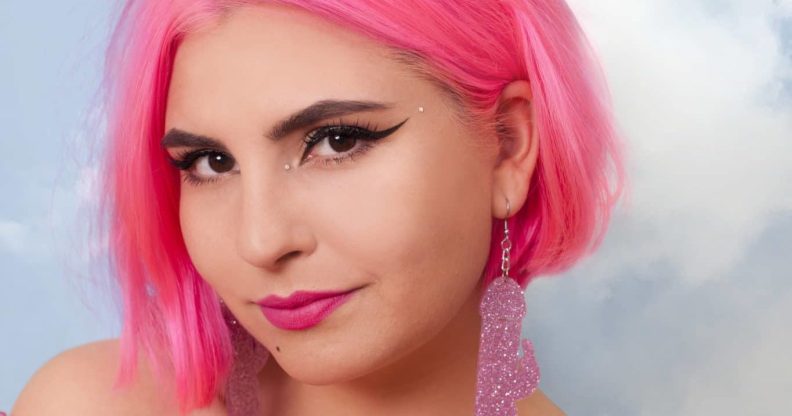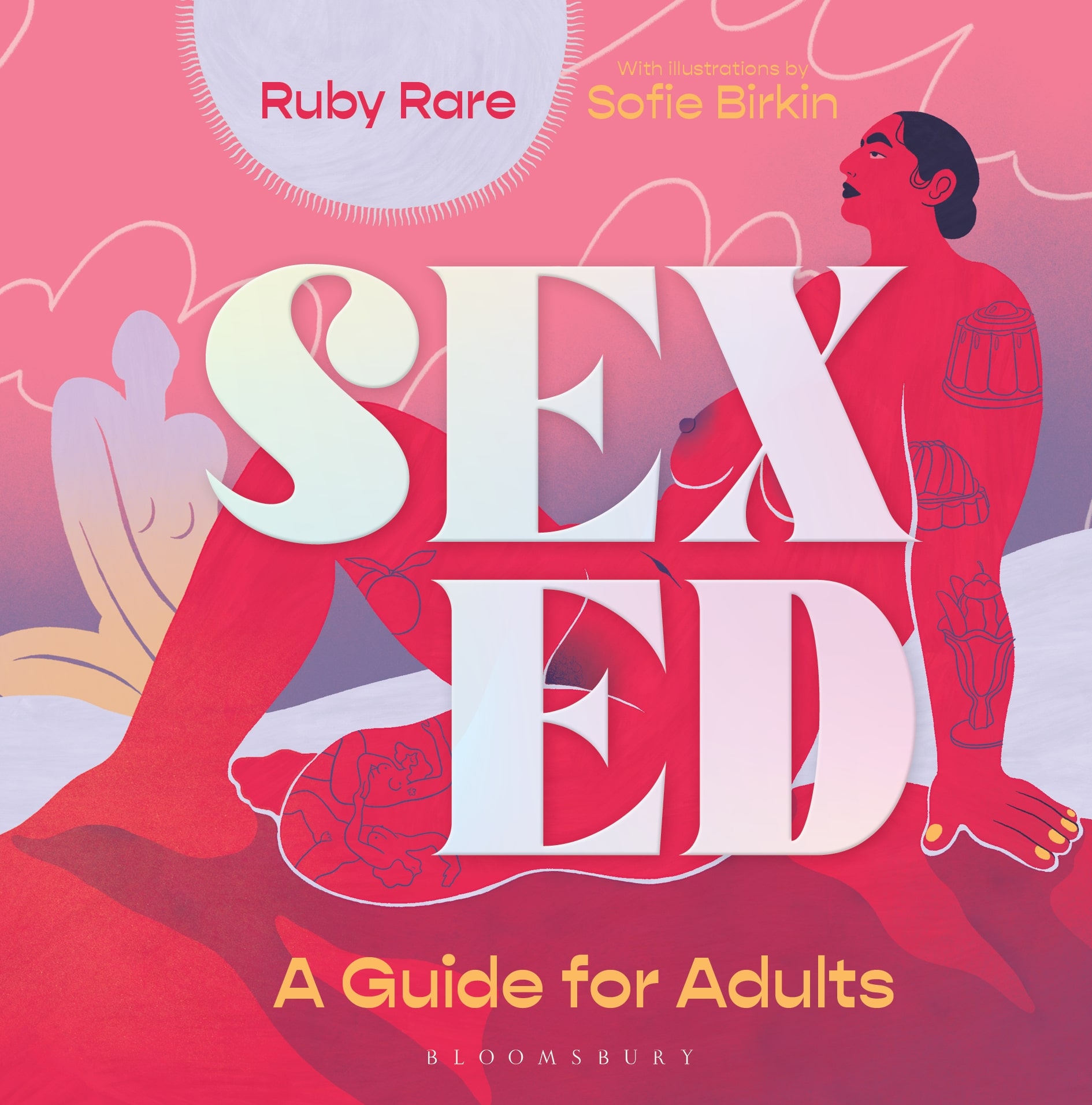15 eye-opening things LGBT+ people need to know to make their sex lives better

Ruby Rare’s first book, Sex Ed, is out now. (Sophie Cunningham)
Ruby Rare is the pink-haired, non-monogamous queer who didn’t teach your sex-education classes at school – although we all deserved to learn about sex from her.
The body-positive sex educator, who is an ambassador for Brook, the sexual health and wellbeing charity for young people, has a few ideas about what school sex ed is getting wrong – starting with there not being enough talking about sex. For Ruby, sex isn’t talked about half as much as it should be. And the conversations we do have about sex, she says, are not focused enough on pleasure.
Over the past five years, Ruby has taught sex and relationships education to thousands of young people. But it was when she did her first talk for adults two years ago – on how to consume porn mindfully – that she realised adults need access to this education as well.
“I realised that all of the adults in that room had as many questions as the young people that I was teaching,” Ruby tells PinkNews. “Often, they were the same questions that young people were asking me.”
“There’s nothing wrong with wanting to learn, or needing to learn, or not knowing things,” she adds. And because adult sex education is so often overlooked or focused on things that Ruby doesn’t think are very helpful, like “how to spice up your sex life”, it was really exciting for Ruby to aim her debut book squarely at adults.

Sex Ed: A Guide for Adults, published by Bloomsbury, is about “getting back to basics”, Ruby says. “What do you want to do? How do you recognise your agency? And how do you communicate this with other people?” she explains. “And then how do you do all the fun sexy stuff, on top of that?”
Sex Ed answers these questions, and more, in a gentle, creative, instructive and indisputably sexy way, accompanied by gorgeous illustrations, by Sofie Birkin, of diverse bodies doing the fun sexy stuff. There are also a lot of jelly cameos – as we learn in Sex Ed, pretty much anything can be a fetish.
From solo sex and toys to the science of feeling sexy, here are 15 things that your sex-education classes at school got wrong, or simply forget to tell you altogether.
1. Ruby Rare explains that humans are sexual from birth.
Despite what we often hear, it’s perfectly normal for us to feel sexual curiosity as children. Holding our own genitals or being curious about other people’s genitals is part of our development – but because we so rarely speak about this, and because adults will often shut down this behaviour if they see it in children, we learn to feel shame from a young age about our sexual curiosity.
2. Consensual sex is meant to be fun.
Ruby Rare writes: “The content of your school sex ed may have been accurate, but if it was presented to you by an embarrassed teacher who would literally rather be anywhere else in the world that in that classroom, their delivery is likely to impact you as much as the content itself.” Has a more accurate sentence ever been written?
The first few chapters of her book hammer this message home: Sex is supposed to be fun, and by recognising and unpicking the negative messages we received about it growing up, we can learn the tools to have consensual, pleasurable sex.
She tells PinkNews: “All of us are walking around with this inherited expectation, this pressure of what sex should be. And all of us are trying, either trying to reach that or feeling a lot of shame and guilt for not fitting into that in any way.
“I genuinely feel quite upset when I think about that, because how differently would all of our attitudes towards sex be, if from the very beginning, we were just taught that there is no definitive way to have sex, nobody should be having sex in a particular way, the way that you should be having sex is the way that feels right for you!”
3. Sex starts in your brain.
The human brain contains a model of the entire body, where the scale is based on the sensitivity of each body part. It’s called the cortical homunculus, and it’s in the part of the brain that processes touch. Sex literally begins here – and it’s why, as Ruby explains, many people need to be in the right frame of mind and environment to want to have sex.
View this post on Instagram
4. The accelerator and the brake.
At school, did you also learn that being turned on meant an erect penis… and little else? Yep, us too. But as Ruby introduces in Sex Ed, newer studies into sexual arousal have gone beyond what physically happens to our bodies (and included the arousal of all genders!) – and one, the dual control model, completely changes how we understand desire.
Think of it like driving: the accelerator sends signals from brain to genitals whenever it spots something sexy, whether that’s mental or physical, and tells them it’s on. The brake is the opposite – and it’s incredibly important. It picks up on unsexy things, like danger or discomfort, and signals to your genitals that it’s off. With this model, we learn that feeling sexy isn’t just about being turned on – it’s also about turning off all the things that turn us off!
5. Queerness can evolve over time, and that’s OK.
This may sound obvious, but Ruby really emphasises that everyone’s experience of their sexuality is OK: whether you’ve always been attracted to the same gender or genders, whether your sexuality has changed over time, whether you’re still figuring out your sexual orientation, whether you keep your sexuality private, or whether there are genders you’re attracted to that you haven’t had sex with. It’s all OK!
6. Bisexuality includes all genders.
Like other bisexual women, Ruby isn’t on board with the idea that bisexuality is “bang in the middle of gay and straight”.
“I define my bisexuality as being attracted to my own and other genders, which includes non-binary and intersex folks,” she writes, adding that being bi isn’t something that needs proving, and that being in a straight-presenting relationship doesn’t make a person any less queer.
7. Vaginas and vulvas are not the same thing.
Sure, school sex ed may have shown you a labelled diagram, but that embarrassed teacher and emphasis on penis-in-vagina sex probably means the lesson didn’t stick. And given that the majority of pleasure lies in the vulva, erasing this word limits the amount of pleasure those with vulvas can have. Learning this distinction was a “game changer” for her sex life, Ruby writes.
View this post on Instagram
8. But the clitoris and penis are basically the same thing.
In a chapter called “On to the Sciencey Stuff”, Ruby Rare explains that for the first six weeks, all fertilised eggs develop in the same way. When it comes to our genitals, our sexual organs are at their core really quite similar – they’re just structures slightly differently. The biological term for this is homology.
Both the penis and clit are made of erectile tissues, which fill with blood and swell up when we’re aroused. They both have glans, where nerve endings are concentrated; they both extend into the body from the base; and they are both formed from the same foetal tissue.
9. Biological sex isn’t binary.
Intersex people exist! Ruby describes intersex people as having hormones, chromosomes and/or genitalia that can be different from “typical male or female bodies”.
10. Clitoris’s get erections, too!
IMAGINE LEARNING THIS IN SCHOOL. You’ll have to buy the book for the two glorious, illustrated pages all about the clitoris – as Ruby describes it, “the star of the show”.
View this post on Instagram
11. The hymen doesn’t exist…
Nope. There is something called a vaginal corona in the place where we’re taught the hymen is, but the way we’re taught a hymen keeps all the chastity inside is, to use the technical term, total bullshit.
12. … and ‘virginity’ is a patriarchal myth.
Which Ruby Rare busts very succinctly: “The common myth that people with vaginas always bleed when they ‘lose’ their ‘virginity’ is mostly down to a lack of arousal and lube.”
13. Consent.
“Right now, I think we are introduced to consent in a way that elicits fear, like fear of getting it wrong,” Ruby Rare says. “Consent is made to seem like this overly formal business transaction that no one is equipped to do in real life.”
If you were lucky enough to be taught about consent at school, it’s likely this involved a man seeking consent from a woman. And while teaching consent is now mandatory, it relies on the simplified “no means no”. But there are many ways that we say no without actually saying the word no – like deflecting, postponing or making an excuse.
And there are also many ways we can say yes. By thinking about pleasure-focused consent, Ruby explains that we can emphasise enthusiastically consenting to the things we do want – improving our sexual pleasure.
14. Anything can be a fetish!
As she explained to PinkNews, Ruby’s is jelly. “It has always been something that I have just delighted in, in a completely non-sexual way,” she explains.
“I just think it’s the most entertaining type of food in the world. And as a child, I loved it. And as an adult, I still love it.
“And then a few years ago, in the conversations I was having around fetish and about sexual desire, I realised that jelly really turns me on and it’s genuinely sexy, and it’s really nice to permit myself to feel sexually aroused by delicious, wobbly, inanimate object.
“And the more that I allowed myself to feel that, the more real it became for me. So I now kind of think, like, I definitely have a jelly fetish.”
15. Keep your socks on.
According to Ruby Rare, studies have shown that it’s easier to orgasm while wearing socks. Yes, really.
To read more, buy Ruby’s book Sex Ed: A Guide for Adults here.

